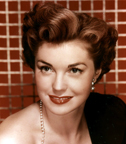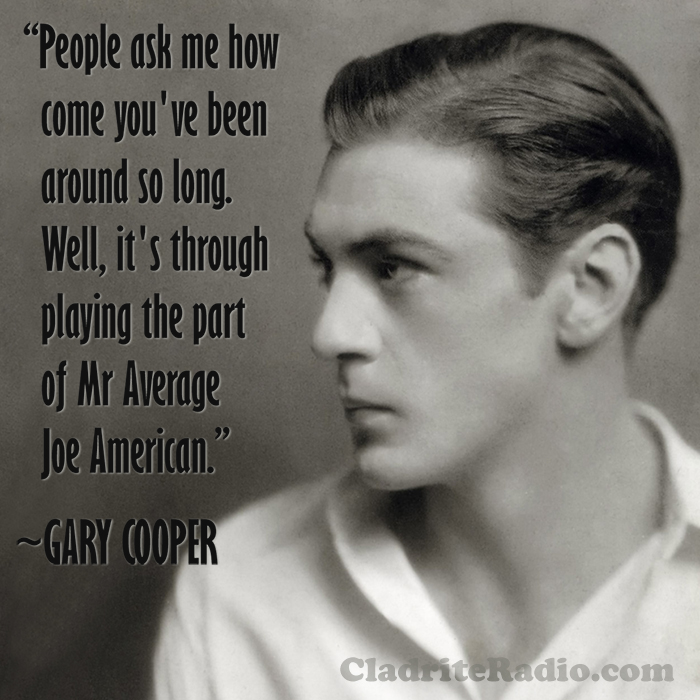Gary Cooper was born Frank James Cooper 119 years ago today in Helena, Montana. His versatility was somewhat belied by his understated approach to the craft of acting.
Tag: Gary Cooper
10 Things You Should Know About Dana Andrews
Here are 10 things you should know about Dana Andrews, born 111 years ago today. We enjoyed a brief in-person encounter with Andrews back in the 1980s; he had a quiet dignity we admired.
Warren William Goes on the Run!
 Though he may not be well remembered by your average Jill or Joe, for movie buffs, Warren William is an icon of 1930s Hollywood—especially the pre-code years.
Though he may not be well remembered by your average Jill or Joe, for movie buffs, Warren William is an icon of 1930s Hollywood—especially the pre-code years.
Though he played a few good guys, William’s typical character ranged from roué to to cad. He is, for fans of 1930s cinema, the man we love to hate. As Roger Fristoe wrote for tcm.com, “William played his fast-talking, opportunistic characters with such style and dash that Depression-era audiences often found themselves rooting for him.”
William was a creature of the city, more urbane sophisticate than rough-and-tumble he-man. One can easily picture, say, Clark Gable or Gary Cooper feeling quite at home in the great outdoors, but somehow not William. And yet, William remained trim and fit until the end. He was broad-shouldered and had a narrow waist, and one would assume, because he appeared so fit, that he was athletic and active, in the gym if not on various fields of play.
But how, then, to explain the way he ran? (His daffy dash begins at the 30-second mark in the video below.) Mind you, we’re in no position to mock anyone else’s athletic abilities (it’s usually we who are being mocked), but we’ll admit that William’s sidewinding caper (as seen here in The Lone Wolf Spy Hunt) made us giggle.
Cagney Under the Stars!
Imagine you’re at the drive-in, watching a war picture, and James Cagney pulls up in the space next to you.
That’s what happens in this memorable scene from White Heat (1949). Cody Jarrett (Cagney), on the lam with Ma Jarrett (Margaret Wycherly) and his wife, Verna (Virginia Mayo), after shooting a police detective, eludes the cop in hot pursuit by making a quick right turn into the San-Val drive-in as the police siren recedes into the distance.
The theatre’s marquee touts a double feature of South of St. Louis (1949) and Siren of Atlantis (1949), but the movie actually seen on the screen as Cody and Co. settle in to discuss their plans is Task Force (1949), starring Gary Cooper and Jane Wyatt.
We enjoyed seeing the uniformed attendants offering peanuts and popcorn and placing the speaker just so in the passenger-side window. We couldn’t help but wonder just how many such attendants the San-Val employed on a busy Saturday night back in 1949 (if, in fact, it employed any attendants; it’s possible that was a creative touch added by the producers of the picture)
Burbank’s San-Val, the second drive-in ever built in California, opened in 1938 (the first, called The Drive-in Theatre, opened for business in 1934 at 10850 W. Pico Boulevard in Los Angeles) and was shuttered in the mid-1970s. The theatre, which originally had a capacity of 590 cars (it later accommodated more than 800 cars), was located at 2720 Winona Avenue, at the confluence of Winona, Naomi Street and San Fernando Road. An office building housing a number of movie production and effect houses now occupies the spot.
Esther Williams: A Life Aquatic
 We were sorry to learn that the always lovely Esther Williams has backstroked off to the deep end of the pool at the age of 91.
We were sorry to learn that the always lovely Esther Williams has backstroked off to the deep end of the pool at the age of 91.
So we thought it an apt time to share (once again) with the Cladrite community an interview we did with the divine Ms. Williams some years ago on the occasion of the publication of her memoir, The Million Dollar Mermaid: An Autobiography.
Enjoy! But wait at least an hour after eating before beginning this Q&A.
An Interview with Esther Williams
In the 1940s and ’50s, Esther Williams was one of the brightest stars in MGM’s galaxy. Her movies, with their memorable Busby Berkeley-choreographed aquatic extravaganzas, remain hugely popular today in revival houses and on cable television.
And now, with the publication of her autobiography, Williams shares candid tales of her life as Hollywood’s “Million Dollar Mermaid.” We chatted with Ms. Williams about a wide range of topics, from her husband Fernando Lamas‘s sometimes philandering ways to cross-dressing in Hollywood. It was a conversation as lively and open as her book, The Million Dollar Mermaid: An Autobiography.
As we read your book, it struck us that you’ve have had a life filled with extreme highs and lows. There have been so many wonderful chapters in your life, but so many sad and tragic events as well.
It’s the idea that you’re smiling underwater—doing the impossible!—and then going home to a life that’s unraveling around you…I was struck with it, too. You know, writing your autobiography is therapy. You get in tune with a lot of things you thought you’d forgotten.
Fernando [Lamas] had asked me years ago not to be in the movies or television or do interviews anymore; as I say in my book, he asked, “Can you stop being Esther Williams?” And I said, “Well, that’s an interesting idea; I’ve been her for a lot of years. Let’s see how I do without her.”
And when Fernando died in 1982, the thing I noticed about the death of a life partner, especially one as difficult as Fernando was—when they go, you’re out of a job! The first person that called me after he died was Shirley Maclaine, who is my friend, and she said, “Well, Esther, you can finally get out of the house.” And I thought, Oh, Shirley, you tell it like it is. I’m so very fond of her.
And then Barbara Walters called. And I said, “Oh, Barbara, I haven’t been photographed in 20 years!” The one thing that Katharine Hepburn said that really made sense to me is that good thing about the talk shows is that people get to watch you rot. And I said, “I’ve been rotting in private!” And she said, “I’ve seen you at parties and you don’t look like you’re rotting to me. I want you to come and do one of my specials.” I said, “I’m not going to look good next to Jane Fonda or Sally Field.” And she said, “I won’t put you next to Jane Fonda and Sally Field; I’ll put you in the middle segment—we’ll put Mr. T before you and Howard Cosell after you, two of the ugliest men in the world.” And I said, “Oh, then I’ll do the show—of course!” [laughs]
Early in the book you detail a clinical experience with LSD. Later, you reveal that you were the victim of a rape at the hands of a family friend when you were a young woman, that your older brother died a tragic death when he was just in his teens. Was the book a form of catharsis for you?
You know, we seem to acquire, as we age and deal with various diminished capacities, an ability to articulate our feelings. To say, “No, no, you don’t understand. It wasn’t that way; it was this way.” And what happened to me is that, when I would go through the problems of day-to-day living, it was always wonderful to go to the studio and dive into that wonderful water. The water was very healing for me, and it remains so even today. I’m in my 70s. I had a knee replaced not so long ago and was going through physical therapy, and it hurt, you know? They’ve got to bring the muscles along, and it hurts.
So I said to Mark, my physical therapist—he came to my house to work with me, and he didn’t know how to swim—I said, “You’re $60 an hour, Mark. And you hurt. I don’t want to be hurting anymore; I’m going to get in the pool. And I tell you what we’ll do—we’ll call the $60 a push, because that’s what I’ll charge you for your swimming lesson. And I got him swimming, and he loved it.
What an opportunity for him, to receive a swimming lesson from Esther Williams! That’s a rare opportunity.
I thought it was worth the $60! Candy Bergen rang my doorbell one day and said, “I want [her daughter] Chloe to learn to swim.” And I said, “If you wanted her to learn to play piano, would you ring Artur Rubenstein‘s door?” And she said, “I don’t care if she plays piano, but she’s got to learn to swim.” And I said, “Yes, that’s true. Because that can save her life. Piano won’t ever save her life.”
Are you pleased—or perhaps surprised—by the rise of women’s athletics? Would you ever have imagined the sort of attention that’s been lavished on the U.S. women’s soccer team or the Olympic basketball players and gymnasts?
And synchronized swimming! It’s an Olympic sport now. Yes, it’s very exciting.
Read More »

